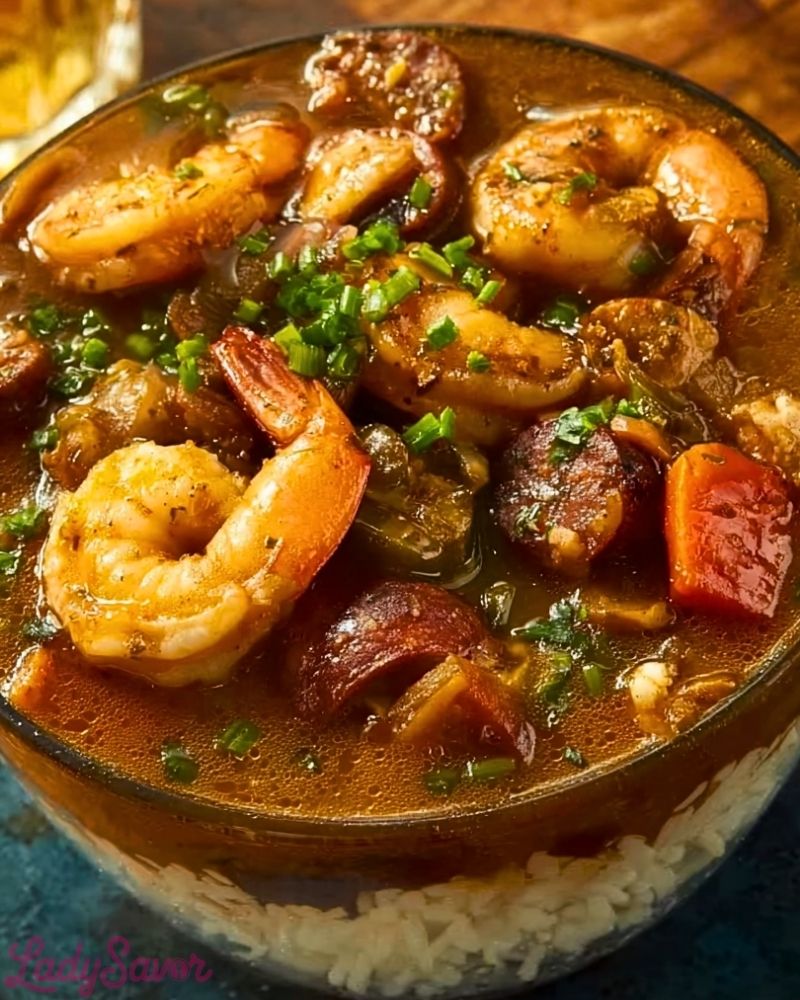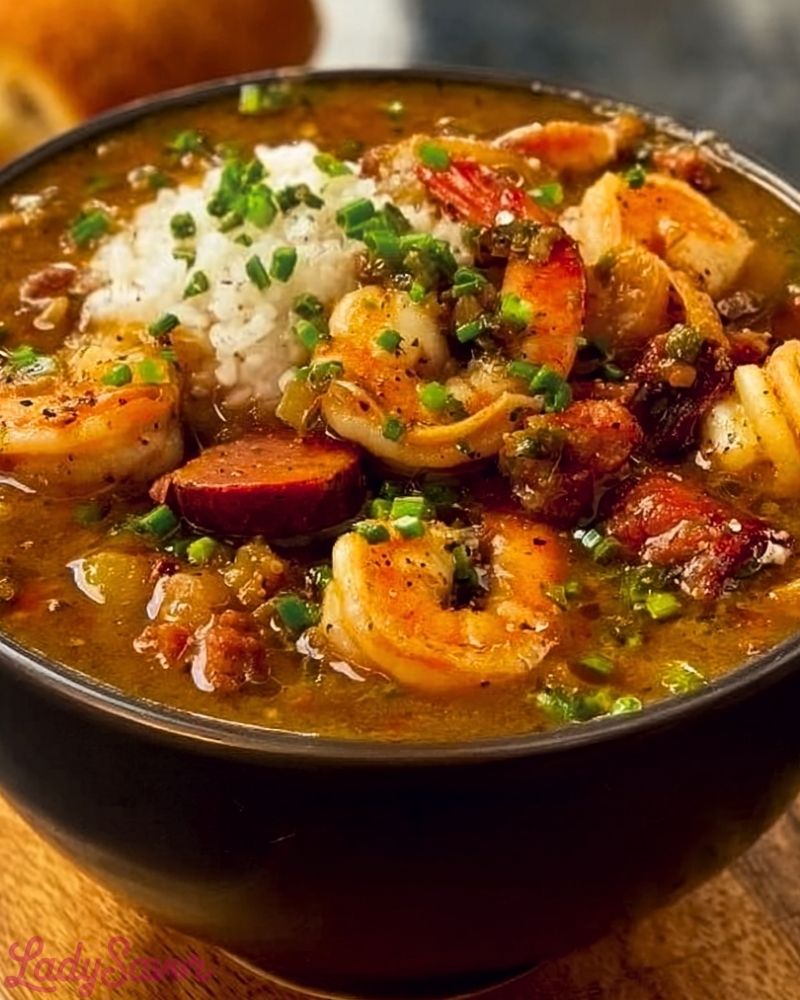If there’s one dish that always takes me back to my roots, it’s a big, steamy bowl of Louisiana Seafood Gumbo. Every time I cook it, the scent alone fills the kitchen with that unmistakable mix of smokiness, spice, and warmth. It’s one of those soulful meals that feels like a hug—rich, hearty, and brimming with flavor from land and sea. I remember standing beside my grandmother’s stove as she stirred the roux with absolute focus, teaching me that patience and love were just as important as shrimp and sausage.

This gumbo is the kind of recipe that brings people together. Whether it’s a weeknight dinner or a Sunday gathering, this bowl carries with it tradition, comfort, and celebration. It’s layered with textures—tender shrimp, smoky andouille sausage, chunks of crab, okra, and a deep, savory broth with that signature kick. Served over a scoop of fluffy white rice, this dish is what Southern food dreams are made of.
Why You’ll Love This Louisiana Seafood Gumbo
Louisiana Seafood Gumbo is a masterpiece of Cajun-Creole cooking. It’s not just a soup or a stew—it’s an experience. You’ll love how every bite delivers a balance of briny seafood, spicy sausage, and a thick, rich base created from a dark roux and classic vegetables. The recipe is flexible enough to suit your taste, yet authentic enough to honor the culture behind it. Plus, it’s even better the next day, making leftovers something to truly look forward to.
What Kind of Seafood Should I Use in Louisiana Seafood Gumbo?
The beauty of gumbo is how customizable it is—especially when it comes to the seafood. I usually go with a hearty mix of large shrimp, lump crab meat, and sometimes oysters if they’re fresh and in season. Gulf shrimp are ideal because of their firm texture and natural sweetness, but really, any good-quality shrimp will work. Crab adds a delicate richness to the pot, and if you’re feeling extra traditional, a few blue crabs (in the shell) bring tons of flavor. Crawfish tails are also a delicious addition if you can get your hands on them.
Options for Substitutions
Don’t worry if you can’t find every ingredient—gumbo is as forgiving as it is flavorful. If you don’t eat pork, swap out the andouille sausage for turkey sausage or a plant-based version. Can’t find okra? Use file powder (ground sassafras leaves) to thicken the gumbo instead. Some people even leave out tomatoes entirely, depending on whether they lean more Cajun or Creole. You can also skip oysters or crab and just double the shrimp if you’re looking to keep it simple without sacrificing taste.
Ingredients for This Louisiana Seafood Gumbo
Shrimp (peeled and deveined)
This is the star of the gumbo—sweet, tender, and quick to cook. Shrimp adds a briny depth that defines the seafood flavor.
Lump Crab Meat
Brings a delicate richness and soft texture that balances the bolder flavors of sausage and shrimp.
Andouille Sausage
Smoky, spicy, and meaty—this sausage adds complexity and a slight heat that’s essential in authentic gumbo.
Okra (sliced)
Traditionally used as a natural thickener, okra also provides a unique texture and slight earthiness.
Bell Pepper, Celery, and Onion (The Holy Trinity)
These three vegetables form the flavor foundation of almost every great Louisiana gumbo.
Garlic (minced)
Adds sharp, aromatic depth that rounds out the savory profile.
Tomatoes (diced, optional)
Adds acidity and color—especially common in Creole-style gumbo.
Seafood or Chicken Stock
Provides the rich base for the gumbo. Seafood stock enhances the ocean flavor, while chicken stock works well too.
Flour & Oil (for the roux)
This is where the magic starts—a dark, rich roux gives gumbo its signature depth and color.
Cajun or Creole Seasoning
A blend of spices that delivers the signature heat and boldness—usually including paprika, cayenne, thyme, and garlic powder.
Bay Leaves & Thyme
Adds herbaceous, earthy notes that simmer into the gumbo as it cooks.
Green Onions & Fresh Parsley
Used as a bright, fresh garnish to finish off the dish and add a pop of color and flavor.
Cooked White Rice
The essential base to serve with the gumbo—it soaks up that flavorful broth and ties it all together.

Step 1: Make the Roux
Start by heating equal parts oil and flour (usually ½ cup each) in a large heavy-bottomed pot over medium heat. Stir constantly with a wooden spoon for about 20–30 minutes until the roux turns a deep, chocolate brown. Don’t rush this step—it’s the backbone of the gumbo’s flavor.
Step 2: Sauté the Holy Trinity
Once the roux is ready, immediately add the diced onions, bell peppers, and celery. Stir well and cook for about 5–7 minutes until the vegetables are softened. Add the minced garlic and cook for another minute.
Step 3: Add the Sausage and Seasoning
Toss in the sliced andouille sausage and let it brown slightly in the pot. Stir in Cajun or Creole seasoning, bay leaves, thyme, salt, and black pepper. If using tomatoes, add them here and cook for another 5 minutes.
Step 4: Pour in the Stock and Simmer
Slowly pour in your seafood or chicken stock while stirring to combine everything. Bring to a gentle boil, then reduce to a simmer. Let it cook uncovered for about 30–40 minutes so the flavors meld beautifully.
Step 5: Add the Seafood and Okra
Toss in the shrimp, crab meat, and okra. Simmer for another 10–15 minutes until the shrimp are pink and cooked through and the okra is tender. Taste and adjust seasoning if needed.
Step 6: Serve Over Rice and Garnish
Scoop hot, cooked white rice into bowls and ladle the gumbo generously over the top. Finish with chopped green onions and parsley for a fresh, vibrant touch.
How Long to Cook the Louisiana Seafood Gumbo
The entire cooking process takes about 1 hour and 30 minutes, but most of that is hands-off simmering. The roux alone takes a good 20 to 30 minutes, and that’s non-negotiable if you want that deep, nutty flavor. Once you add the stock, give it at least 30 to 40 minutes to simmer, and then another 10 to 15 minutes after the seafood goes in. The goal is to layer the flavors and let them fully develop—not rush through it.
Tips for Perfect Louisiana Seafood Gumbo
- Don’t rush the roux. Stir constantly, and don’t let it burn. A dark roux is what gives gumbo its rich, almost smoky base.
- Use fresh, quality seafood. Especially with shrimp and crab, freshness makes all the difference in flavor and texture.
- Let the gumbo rest. Like many stews, gumbo tastes even better after a few hours—or the next day—once the flavors have had time to deepen.
- Taste and season as you go. Cajun seasoning blends vary in salt and heat, so adjust accordingly to your taste.
- Serve it hot, but not boiling. Let the gumbo cool slightly before serving to really taste all the complex flavors.
- Keep the rice separate. Add it to each bowl as you serve to avoid it getting mushy in the pot.
Watch Out for These Mistakes While Cooking
-
Burning the Roux
This is the most common (and fatal) mistake. If the roux turns black or smells scorched, you need to start over. A burnt roux will ruin the whole pot. -
Adding Seafood Too Early
Overcooked shrimp and crab become rubbery. Only add them near the end of cooking so they stay tender. -
Skipping the Simmer
That 30- to 40-minute simmer after adding stock isn’t optional—it’s when all the flavors blend and deepen. -
Using the Wrong Sausage
Andouille is key for its smoky, spicy flavor. Mild or sweet sausage won’t bring the same boldness. -
Underseasoning
Gumbo needs strong seasoning. Taste as you go, especially after adding stock and seafood. -
Overloading with Ingredients
It’s tempting to toss everything in, but restraint keeps gumbo balanced. Stick to a few high-quality seafood choices and let them shine.
What to Serve With Louisiana Seafood Gumbo?
Cornbread
A slice of warm, buttery cornbread is perfect for soaking up the flavorful broth.
Crusty French Bread
Great for dipping and adds texture to the meal. A classic Southern pairing.
Potato Salad
Some Louisianians serve a scoop in the gumbo—try it! It cools the spice and adds creaminess.
Collard Greens or Mustard Greens
These provide a bitter, earthy counterpoint to the richness of gumbo.
Fried Okra
A crunchy snack or side that complements the soft, stewed okra in the gumbo.
Cajun Deviled Eggs
Spicy, creamy deviled eggs make a tasty appetizer before the gumbo hits the table.
Sweet Iced Tea
The cool, sweet sip of Southern iced tea balances out the spice and warmth of gumbo beautifully.
Bread Pudding with Bourbon Sauce
If you’re going for a full Louisiana meal, finish it off with this decadent, boozy dessert.
Storage Instructions
Louisiana Seafood Gumbo stores beautifully—some say it tastes even better the next day. Let the gumbo cool completely before transferring it to an airtight container. Store in the refrigerator for up to 3–4 days.
For longer storage, freeze the gumbo without the rice in freezer-safe containers for up to 3 months. Thaw it overnight in the fridge, then reheat gently on the stovetop over low heat to preserve the texture of the seafood. If the gumbo thickens too much, just add a splash of stock or water to loosen it.
Keep rice stored separately in the fridge or freezer and reheat just before serving.
Estimated Nutrition
Please note: these values are approximate and can vary depending on the exact ingredients and portion size.
- Serving Size: 1.5 cups gumbo with ½ cup rice
- Calories: 420
- Protein: 28g
-
Fat: 22g
- Saturated Fat: 6g
- Unsaturated Fat: 14g
- Trans Fat: 0g
-
Carbohydrates: 28g
- Fiber: 3g
- Sugar: 4g
- Sodium: 880mg
- Cholesterol: 145mg
Frequently Asked Questions
Can I make gumbo ahead of time?
Absolutely. In fact, gumbo often tastes even better the next day after the flavors have had time to deepen and meld together. Just reheat it gently and add a splash of stock if it thickens too much.
Can I use frozen seafood?
Yes, frozen seafood works fine. Just make sure it’s fully thawed and patted dry before adding it to the pot to prevent excess water from diluting the flavor.
What’s the difference between Cajun and Creole gumbo?
Cajun gumbo usually skips tomatoes and focuses more on dark roux and rustic flavors, while Creole gumbo often includes tomatoes and has a slightly lighter, more refined taste. This recipe leans Creole with its optional tomatoes and seafood base.
How thick should gumbo be?
It should be thick enough to coat a spoon but still soupy—not as thick as a gravy. The roux, okra, or filé powder usually help achieve that perfect consistency.
Can I make it gluten-free?
Yes! Use a gluten-free flour blend for the roux and make sure your sausage and stock are gluten-free. You can also thicken the gumbo with file powder or okra instead of a traditional roux.
What’s the best rice to serve with gumbo?
Long-grain white rice is traditional. It holds its texture well and doesn’t compete with the gumbo’s bold flavors. You can also use brown rice for a healthier option.
How spicy is this recipe?
It’s moderately spicy thanks to the andouille sausage and Cajun seasoning. You can adjust the heat level by reducing or increasing the seasoning or adding hot sauce at the table.
Can I use chicken instead of seafood?
Definitely! Chicken and sausage gumbo is another classic. Use boneless, skinless chicken thighs, cook them early in the process, and let them simmer until tender.
Conclusion
Louisiana Seafood Gumbo is more than just a comforting meal—it’s a cultural expression simmered in one pot. It invites patience, appreciation for bold flavors, and a love for Southern heritage. Whether you’re recreating a family tradition or diving into gumbo for the first time, this dish delivers warmth, spice, and heart in every spoonful. So grab your biggest pot, take your time with that roux, and let the aroma of the bayou fill your kitchen.

Louisiana Seafood Gumbo
- Total Time: 1 hour 30 minutes
- Yield: 6 servings 1x
Description
A big, bold, and comforting Southern dish, this Louisiana Seafood Gumbo brings together shrimp, crab, and sausage in a rich, spiced roux-based broth. Perfect for cozy dinners, weekend gatherings, or anyone craving a deep, flavorful, one-pot meal. Whether you’re searching for a hearty easy dinner, a crowd-pleasing food idea, or a warm and spicy comfort dish, this gumbo checks every box. Ideal for dinner ideas, quick comfort meals, or when you’re in need of bold Southern flavor.
Ingredients
1 pound shrimp, peeled and deveined
1 cup lump crab meat
12 ounces andouille sausage, sliced
2 cups okra, sliced
1 cup green bell pepper, diced
1 cup celery, diced
1 large onion, diced
4 cloves garlic, minced
1 cup diced tomatoes (optional)
6 cups seafood or chicken stock
1/2 cup all-purpose flour
1/2 cup vegetable oil
1 tablespoon Cajun or Creole seasoning
2 bay leaves
1 teaspoon dried thyme
1/2 cup green onions, chopped
1/4 cup fresh parsley, chopped
4 cups cooked white rice
Instructions
1. In a large pot over medium heat, combine oil and flour to make a roux. Stir constantly for 20–30 minutes until it turns deep brown.
2. Add onions, bell pepper, and celery to the roux. Cook for 5–7 minutes, then stir in garlic and cook for 1 minute more.
3. Add sliced sausage, seasoning, bay leaves, thyme, and tomatoes if using. Cook for 5 minutes to build flavor.
4. Gradually pour in stock while stirring. Bring to a boil, then reduce to a simmer for 30–40 minutes.
5. Add shrimp, crab meat, and okra. Simmer for 10–15 minutes until seafood is fully cooked and okra is tender.
6. Taste and adjust seasoning. Remove bay leaves.
7. Serve hot over white rice and garnish with green onions and parsley.
Notes
Let gumbo rest for a few hours or overnight—flavors improve with time.
Use long-grain white rice for best texture and to soak up the rich broth.
If you burn the roux, start over—it affects the entire flavor of the gumbo.
- Prep Time: 20 minutes
- Cook Time: 1 hour 10 minutes
- Category: Dinner
- Method: Stovetop
- Cuisine: Louisiana Creole
Nutrition
- Serving Size: 1.5 cups gumbo with 1/2 cup rice
- Calories: 420
- Sugar: 4g
- Sodium: 880mg
- Fat: 22g
- Saturated Fat: 6g
- Unsaturated Fat: 14g
- Trans Fat: 0g
- Carbohydrates: 28g
- Fiber: 3g
- Protein: 28g
- Cholesterol: 145mg

